Drowning in endless “best tool to send emails” searches? Stop the madness! Instead, dive into this ultimate guide and discover the perfect email partner in minutes. We’ve meticulously tested and reviewed the top 7 email sending tools, saving you 95% of the research hassle. Uncover their strengths, weaknesses, and ideal user profiles - all tailored to your unique needs.
Emails are old. The first email was sent back in 1971. But despite their age, emails are not going anywhere.
According to research, 82% of marketers across the world send emails to spark conversations, find customers, and drive revenue.
For each $1 spent, email marketing generates $42, making it one the most effective ways to grow a business.
But to send emails efficiently, you need the right tools. Emailing software that matches your needs, budget, and technical skills.
And with dozens of email apps competing for your attention, identifying the best tool to send emails can be difficult.
To help you make an informed decision, our team has tested 7 of the most popular emailing platforms ⤵️
In this guide, we’ll review the performance of each platform and share some tips to help you find the ideal emailing tool, based on your unique needs.
| Best Mailing Tools | Pricing | Customer Ratings | Free Plan Available | Best For |
|---|---|---|---|---|
| Mailmeteor | From $9.99 a month | 4.9 | Yes | Cold emails |
| Mailchimp | From $110 a month | 4.5 | Yes | Newsletters and transactional emails |
| Lemlist | From $39 a month | 4.1 | No | Cold emails |
| Brevo | From $25 a month | 4.5 | Yes | Newsletters and transactional emails |
| ConvertKit | From $100 a month | 4.1 | Yes | Newsletters |
| Yesware | From $19 a month | 4.3 | Yes | Cold emails |
Identify Your Email Sending Persona
Before embarking on your quest to find the perfect email sending tool, you must clarify your objectives. And the best way to do that is to define your email sending persona. Here’s a quick questionnaire to help you reach a better understanding of your emailing needs and habits.
1. What’s Your Mission?
- Are you a marketing maestro, crafting captivating campaigns for the masses?
- Are you a prospecting pro, sending cold emails to close deals and drive revenue?
- Are you a social butterfly, sharing daily updates with your friends, family, or your online community?
- Or are you a team leader, fostering cooperation and keeping collaborative projects on their tracks?
2. How Do You Plan to Use Your Emailing Tool?
- Do you want to send hundreds of personalized messages daily? Look for tools with high-deliverability rates and automation features.
- Do you want to send visually appealing newsletters? Search for emailing platforms with drag & drop email builders.
- Do you prioritize security and data privacy? Favor tools with an immaculate reputation and robust security measures.
3. What’s Your Budget?
Are you content with basic features? In this case, you may want to opt for a tool with a generous free plan, like Mailmeteor. Do you require advanced features? Look for affordable paid plans with good value for money. Do you need custom integrations and team access? Enterprise plans offer tailored solutions with a quote-based price.
Exploring these questions should help you gain a crystal-clear understanding of your email sending persona and your emailing needs. Now let’s take a look at the performances of the top emailing platforms.
The 7 Best Tools to Send Emails
To help you find the most adequate tool to send emails, we’ve evaluated 20+ emailing platforms based on dozens of criterias, such as:
- Deliverability – Does the tool provide features to help you avoid spam filters?
- Reputation – What do other users say about the tool?
- Security – Does the tool offer security features to protect your data?
- Ease-of-use – Is the interface intuitive, or does it require a steep learning curve?
- Features – Is the tool equipped with advanced functionalities, like email automation, A/B testing, and personalization?
- Privacy – Does the tool respect your privacy or does it require permission to read your emails?
- Compliance – Does the tool comply with email marketing regulations like GDPR and CAN-SPAM?
- Integrations – Does the tool integrate with other apps and services you use, such as your CRM, marketing automation platform, or calendar?
- Customer support – Does the tool offer good customer support in case you need help?
- Pricing – Does the tool have a free plan, and can the paid plans scale with your needs?
Here are the results ⤵️
1. Send emails with Mailmeteor
Mailmeteor is the #1 emailing platform for Gmail users. You can use this intuitive mail merge solution to send thousands of personalized messages directly from your Gmail account. With 5M+ users worldwide, Mailmeteor has a 4,9/5 rating on the Google Workspace Marketplace out of 11,000+ reviews.
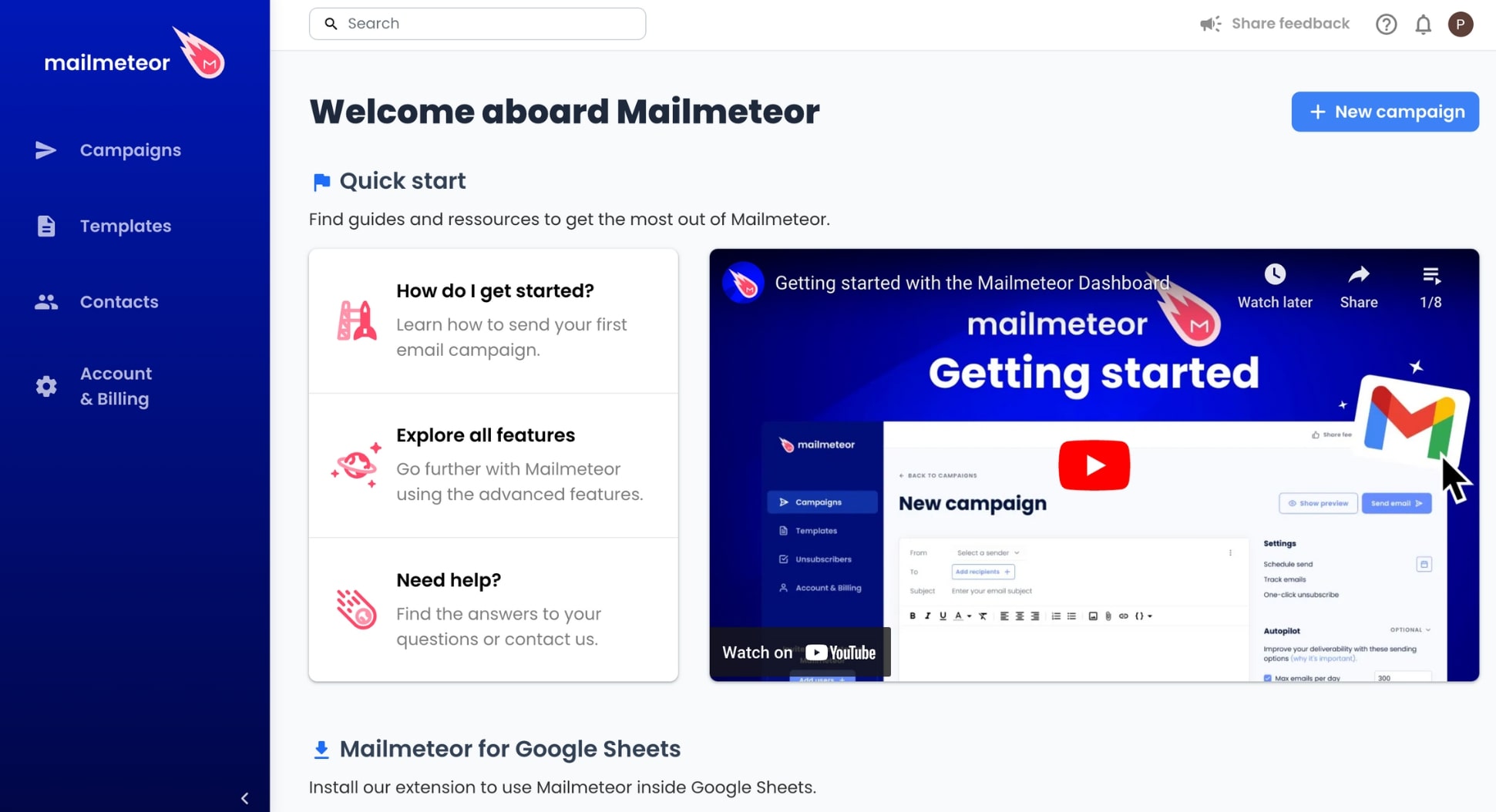
Key Features
- Rich text editor
- Email personalization
- Send emails from an alias
- Email analytics and reporting
- Unsubscribe management tools
- Email throttling and campaign scheduling
- Automated follow-ups and email sequences
- Integration with third-party tools
- Mail merge with attachments
- Built-in email verification
- List segmentation
Pros
- The interface is intuitive. No steep learning curve. You can set up your first email campaign in minutes. No technical skills required.
- You can personalize your emails at scale. To make each recipient feel special without spending hours writing your emails.
- Mailmeteor has one of the best delivery rates on the market thanks to advanced features like BounceShield and Autopilot.
- This app integrates with Google and popular CRMs. So you can send emails directly from your Gmail account.
- You can track your emails in real-time and finetune your emailing strategy based on the data you collect.
- This platform is privacy-focused, meaning that Mailmeteor doesn’t require permission to read your emails, unlike other email sending tools.
Cons
- Mailmeteor doesn’t have a drag & drop builder (you can still create beautifully designed emails by importing your HTML code).
- Mailmeteor abides by the Gmail sending limitations. Which means you can only send up to 2,000 emails a day.
- Mailmeteor was designed to work with Gmail. This email sending tool doesn’t integrate with other email service providers (ESPs), like Yahoo Mail.
- This email platform is not suited for transactional emails, like password reset emails, account creation emails, or shipping confirmations.
Pricing
- Free plan – Send up to 50 emails a day for free.
- Mailmeteor Premium – Send up to 500 emails a day for $9.99 a month.
- Mailmeteor Pro – Send up to 1,000 emails a day for $24.99 a month.
- Mailmeteor Business – Send up to 2,000 emails a day for $49.99 a month.
Ideal for…
Mailmeteor is ideal if you want to do some cold outreach or spark 1-to-1 conversations with a large number of recipients. You can use this emailing tool to communicate more efficiently. At scale. Even with a small budget.
2. Send emails with Mailchimp
With 12M+ users worldwide, Mailchimp is the industry-leading platform for transactional emails and newsletters. This email sending tool offers robust e-commerce options and AI-powered tools. Mailchimp was created in 2001 and is rated 4.5/5 on Capterra out of 16,000 customer reviews.
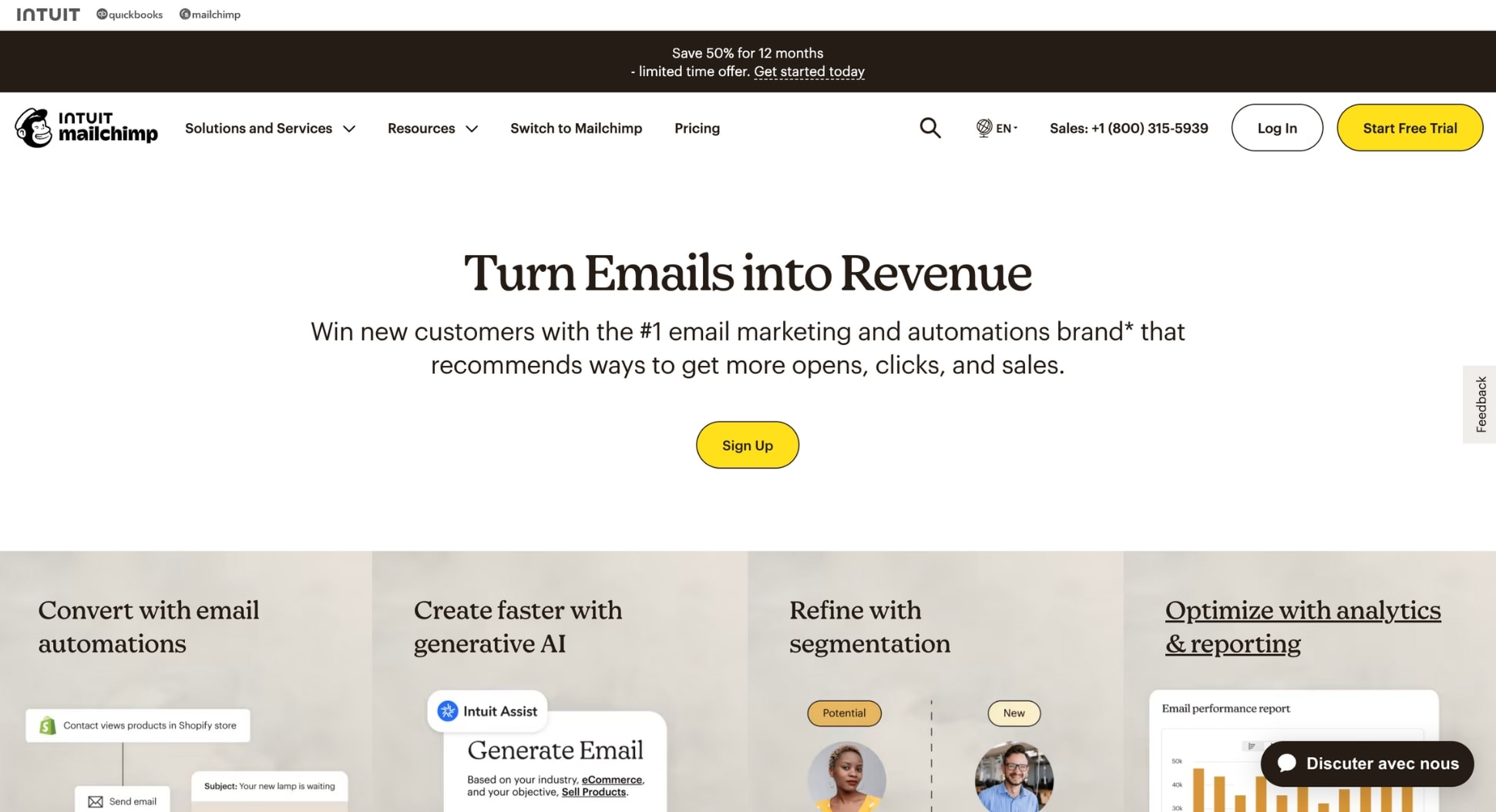
Key Features
- Email scheduling
- Email personalization
- Drag & drop email editor
- Library of pre-designed templates
- Automated workflows and behavioral triggers
- Welcome and cart abandonment emails
- Detailed email analytics reporting
- Multivariate and A/B testing
- Audience segmentation
- Landing page builder
- Built-in CRM
Pros
- Mailchimp offers a generous free plan. This makes it an interesting alternative for beginners and small businesses.
- Mailchimp’s drag & drop editor allows you to create professional-looking emails and landing pages without any coding knowledge.
- This app integrates with most popular CRMs, e-commerce platforms, and social media networks.
- Mailchimp provides detailed analytics reports to track the performance of your email campaigns.
- This emailing platform offers built-in conversion tools to help you turn your leads into customers.
Cons
- Mailchimp can get expensive if you have a large email list.
- You get charged for all the contacts in your list. Even unsubscribed or inactive ones.
- Mailchimp’s customer service is only available via email or chat.
- The free plan includes Mailchimp branding and the available features are (very) limited.
- The interface is not intuitive, making it hard for people with no prior marketing experience to send emails.
Pricing
- Free plan – Mailchimp offers a free plan that includes up to 2,000 contacts and 10,000 emails per month.
- Mailchimp Essentials – Send up to 100,000 emails for $110 a month.
- Mailchimp – Send up to 120,000 emails for $135 a month. -Mailchimp – Send up to 150,000 emails for $350 a month.
Mailchimps’ pricing depends on the number of contacts in your email list. The prices listed above are for a list of 10,000 contacts. Advanced plans also give you access to extra functionalities, like email automation.
Ideal for…
Mailchimp is great for businesses with a small audience who need to send transactional emails. This tool can also fit your needs if you’re looking for an all-in-one platform to design, edit, and send your newsletter.
3. Send emails with Lemlist
Lemlist is a popular alternative to send cold emails. This email marketing platform was created to help sales professionals book more meetings, turn leads into customers, and drive revenue. Lemlist is rated 4.1/5 on G2. It was founded in 2017 and is used by 30,000+ sales representatives and email marketers to send emails.
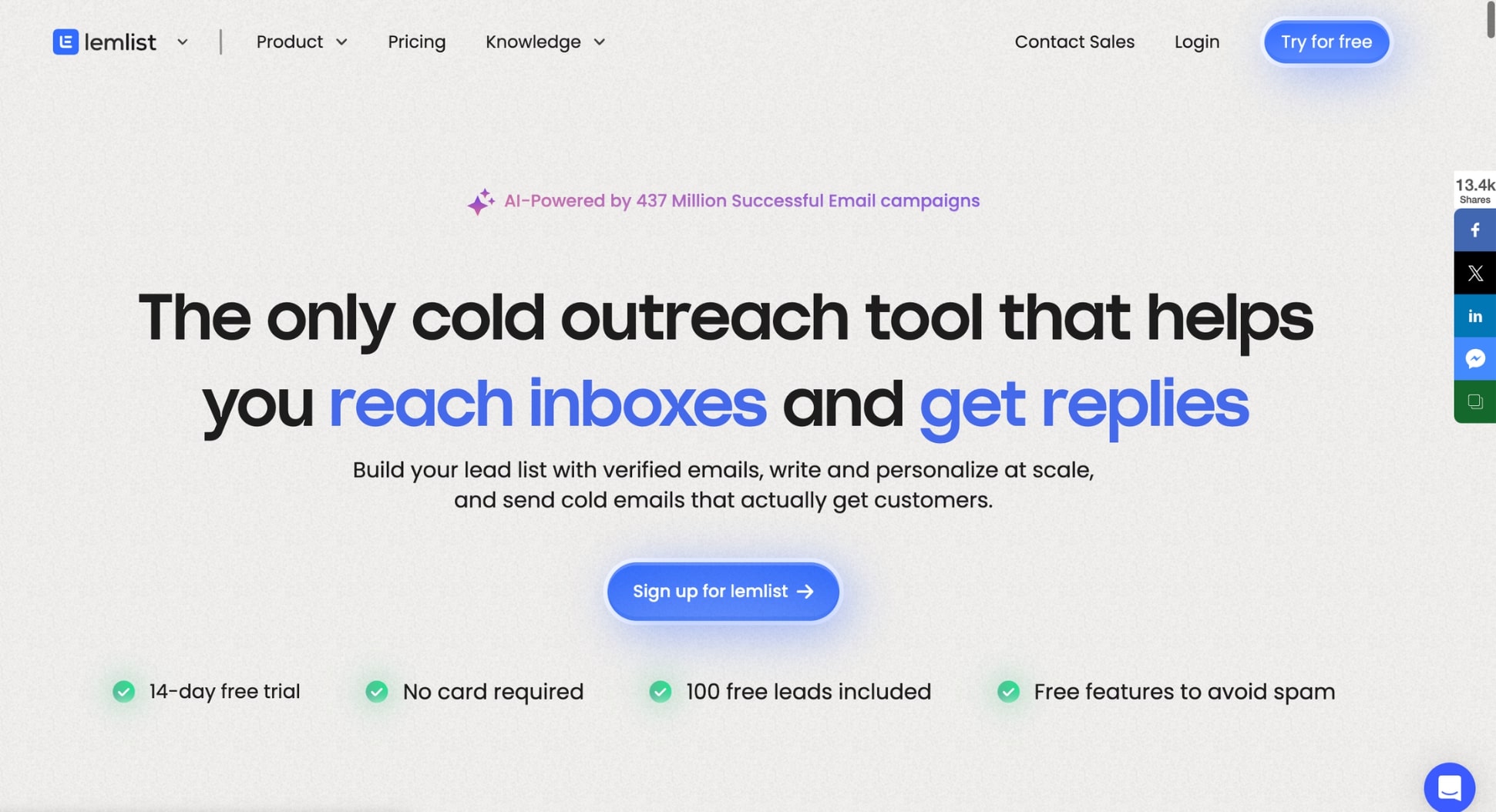
Key Features
- Email warmup
- Email personalization
- Personalized booking page
- Email analytics and reporting
- Automated follow-ups and email sequences
- Email throttling and campaign scheduling
- AI-generated content for your emails
- Integrations with popular CRMs
- Multi-channel automations
- Built-in email verification
- Lead-enrichment tools
- List segmentation
Pros
- Lemlist allows you to customize your emails with dynamic content to create highly-targeted cold email campaigns.
- You can redirect your prospects to personalized landing pages to improve the conversion rates of your emails.
- Lemlist integrates seamlessly with LinkedIn and Sales Navigator, allowing you to scrape data from this platform automatically.
- This email platform lets you multi-step follow-up sequences with triggers and delays for automated outreach workflows.
- Lemlist is also famous for its email warmup tool, called Lemwarm. This feature can help you reach your recipient’s inbox more consistently.
Cons
- You can’t send transactional emails or newsletter with Lemlist. This platform is only helpful if you want to send cold emails.
- Lemlist recommends sending a maximum of 200 emails per day with their platform. Beyond this, your deliverability plummets.
- The interface is clunky. Sending emails from this tool can be challenging if you’re not familiar with email marketing platforms.
- Lemlist is not budget-friendly. Especially for larger teams, since you need to pay extra for each user you want to add.
- Their customer support is only available via email or chat, except if you subscribe to their most expensive plan.
Pricing
- Email Starter – Send unlimited emails for $39 a month.
- Email Pro – Send unlimited emails for $69 a month and get access to Lemwarm and CRM integrations.
- Multichannel Expert – Send unlimited emails for $99 a month and unlock LinkedIn outreach and cold calling functionalities.
- Outreach Scale – Send unlimited emails for $159 a month and get more sites + a dedicated account manager.
Ideal for…
Lemlist was created to help you identify your leads, find their contact details, and send them cold emails to tell them about your brand. This emailing platform has everything you need to get the most out of your cold outreach efforts.
4. Send emails with Brevo
Brevo (also known as Sendinblue) is a multi-channel marketing platform that you can use to send emails, design templates, and manage your contact list. This tool was created in 2012 and is now used by 500,000+ users. It has a 4.5 rating on Capterra based on 2,000+ reviews.
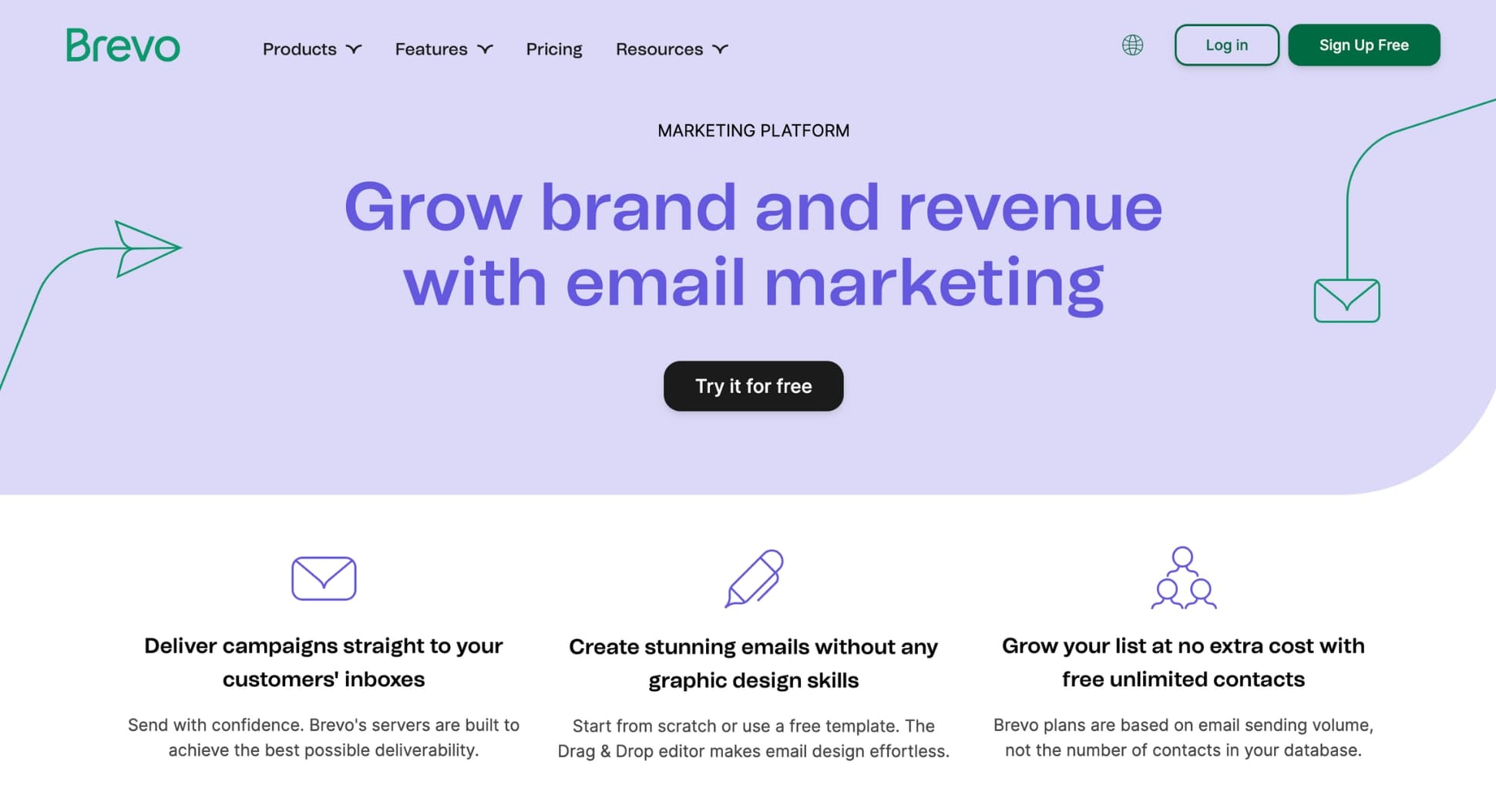
Key Features
- Built-in CRM
- Email scheduling
- Landing page builder
- Drag & drop email builder
- Automated email sequences
- Library of pre-designed templates
- Detailed email analytics and reporting
- Multivariate and A/B testing
- Dynamic personalization
- Email list segmentation
- Send AMP emails
- A/B testing
Pros
- Brevo integrates email marketing, SMS marketing, WhatsApp marketing, live chat, CRM, landing pages, and more.
- The free plan is generous, allowing you to send up to 300 emails a day.
- Brevo has a clean interface that is easy to navigate. Even for beginners.
- Creating emails, landing pages, and other marketing materials becomes easy with their intuitive drag & drop editor.
- Brevo lets you segment and create lists from your contacts without any limitations.
- There are no caps on how many contacts you can have, allowing for scalability and growth without worrying about extra costs.
Cons
- For businesses who need to send daily email blasts to their customers, Brevo can end up being expensive.
- Brevo’s email deliverability has room for improvement. Their deliverability score is fluctuating between 70% and 95%.
- The drag & drop editor sometimes feels laggy and can be a bit slow.
Pricing
- Brevo Free – Send up to 300 emails a day for free.
- Brevo Starter – Send up to 20,000 emails for $25 a month.
- Brevo Business – Send up to 20,000 emails for $65 a month and get access to advanced statistics and marketing automation tools.
Brevo’s pricing depends on the number of emails you send each month. The cheapest paid plans allow you to send up to 20,000 emails. If you want to send more, you’ll need to pay an extra fee.
Ideal for…
Brevo is a good option if you want to create a newsletter, send transactional emails, or craft automated email sequences without technical knowledge. This platform is perfectly suited for beginners.
5. Send emails with ConvertKit
ConvertKit is an email marketing that was designed to help content creators communicate more efficiently with their online community. This emailing software was created in 2013 and 600,000+ solopreneurs, bloggers, and small businesses use it to send emails. It’s rated 4.7 on Capterra based on 200 reviews.
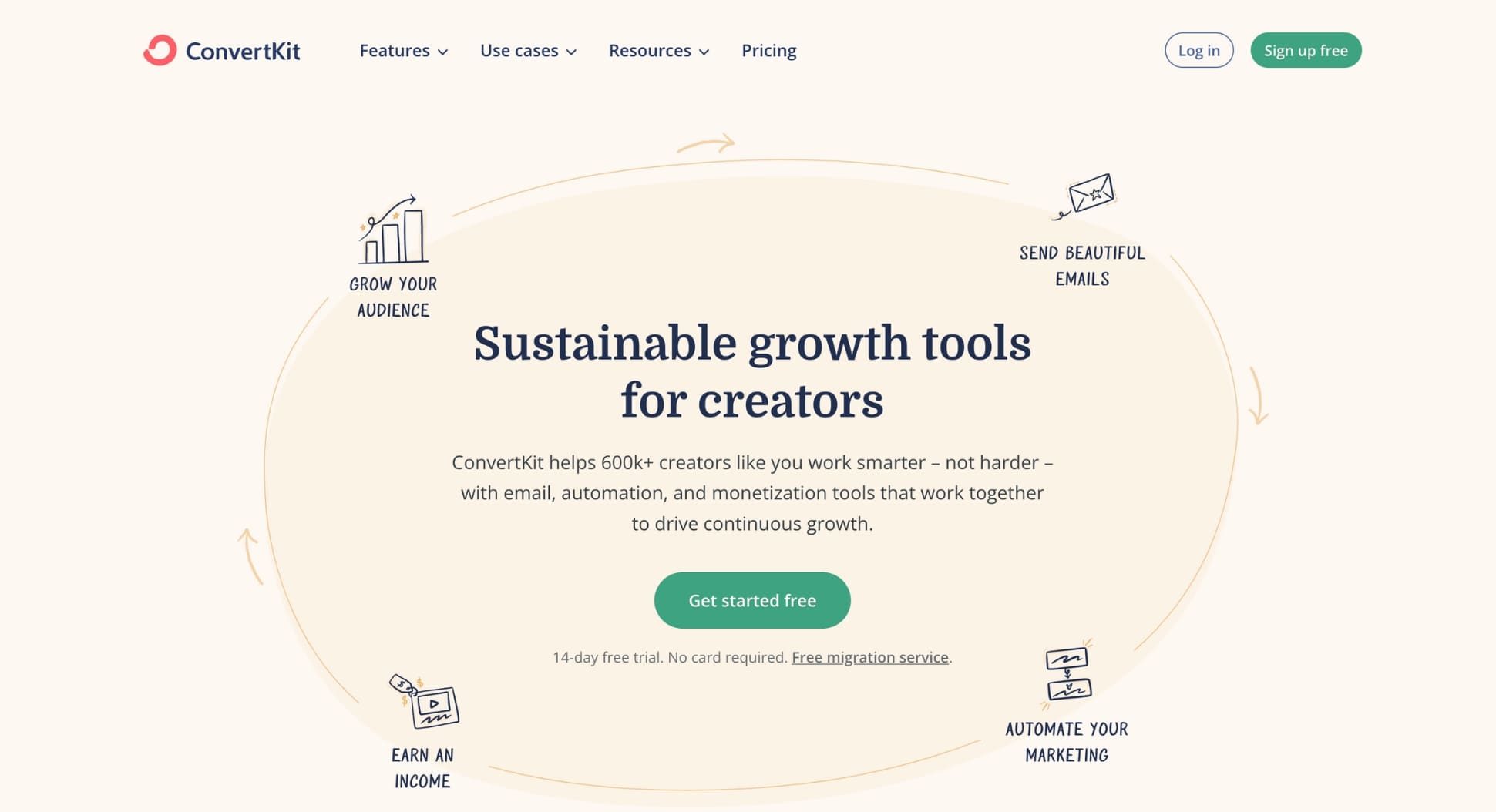
Key Features
- Email scheduling
- Email personalization
- Audience segmentation
- Email analytics and reporting
- Unsubscribe management tools
- Integration with third-party tools and CRMs
- Secure payment processing tools
- Complex automated workflows
- Email deliverability tracking
- Drag & drop email editor
- Landing page builder
- Opt-in form builder
- Paid newsletter
- A/B testing
Pros
- ConvertKit is known for its clean interface.
- You can create complex email workflows intuitively thanks to their visual automation builder.
- ConvertKit has an outstanding email deliverability rate (99.8%).
- A generous free plan allows you to try out the platform before committing to a paid plan.
- ConvertKit allows you to create highly-targeted emails and to segment your audience based on their interests and actions.
- If you want to monetize your emails, you can create paid newsletters subscriptions and sell digital products directly through ConvertKit.
- ConvertKit is known for its responsive and helpful customer support team.
Cons
- ConvertKit provides limited analytics and lacks a dedicated analytics dashboard.
- As your contact list grows, the cost of ConvertKit can become expensive compared to other options.
- The design options for emails and landing pages are limited.
- Scalability might be an issue for businesses with extensive email needs and complex workflows.
Pricing
- Free – ConvertKit is free for up to 1,000 subscribers
- Creator – You can send unlimited emails for $100 a month.
- Creator Pro – You can send unlimited emails for $140 a month and unlock extra features, like subscriber scoring.
ConvertKit’s pricing is based on your number of subscribers. The fees listed above allow you to send emails to up to 10,000 subscribers. If your email list is larger, the costs of using ConvertKit quickly goes up.
Ideal for…
Convertkit is the one of the best email sending tools on the market for creators and content-driven businesses looking for a user-friendly platform to manage email marketing, subscribers, and online sales.
6. Send emails with Yesware
Yesware is a platform designed to send cold emails. This app is rated 4.4 on G2 and 4.3 on Capterra out of 1,000+ customer reviews. Yesware was created in 2010. Over 6,000 sales teams use this tool to optimize their cold outreach process and send emails that generate replies.
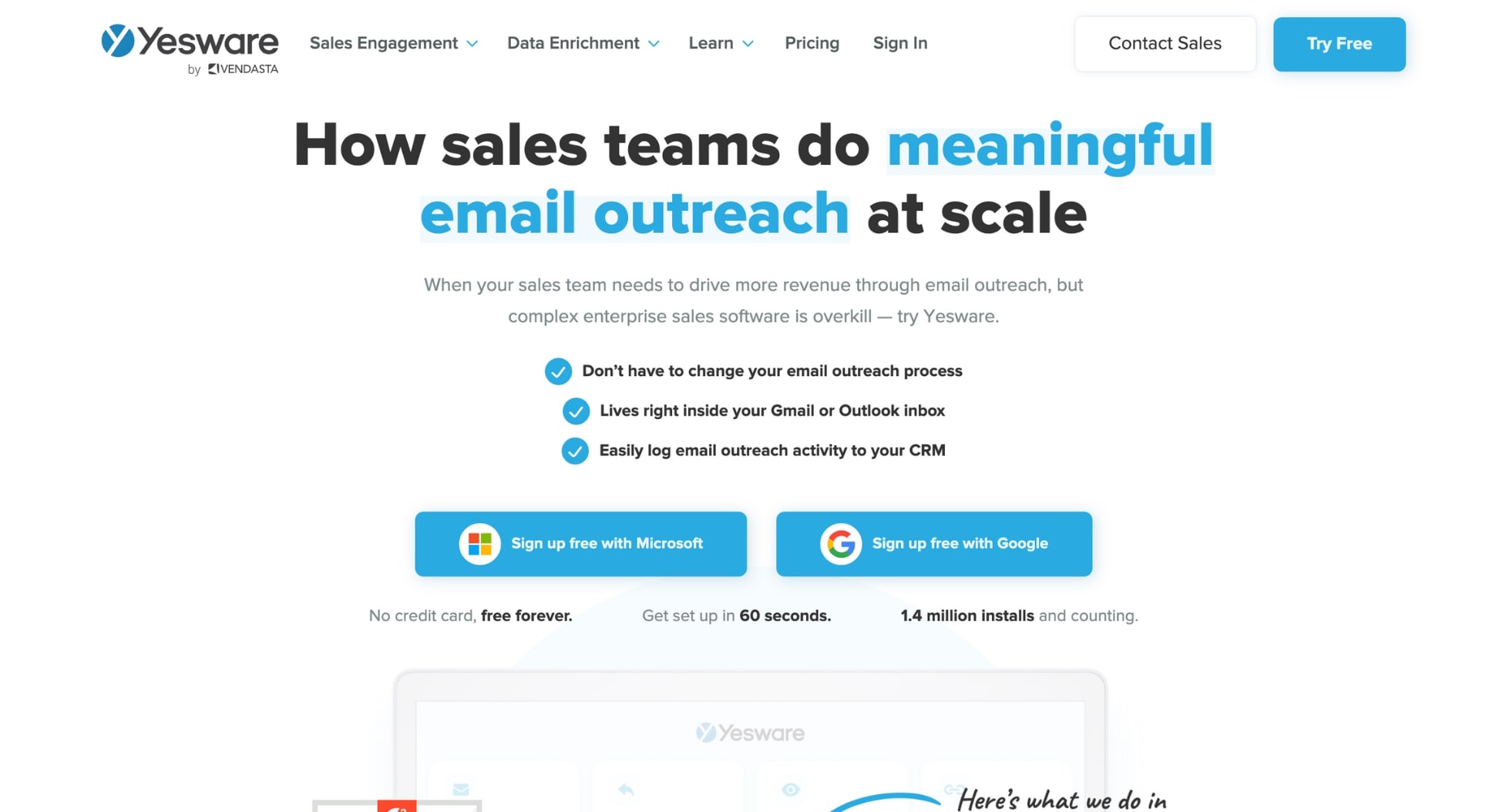
Key Features
- Meeting scheduler
- Email personalization
- Email tracking in real-time
- Automated email sequences
- Recipient engagement reports
- Multi-channel campaigns (LinkedIn, emails, calls…)
- Library of pre-built templates optimized for conversion
- Audience segmentation
- Send later scheduling
- CRM integrations
Pros
- Yesware comes with multi-channel outreach functionalities, allowing you to add calls and social touches to your workflows.
- You can also offer your recipients to book meetings directly from your emails thanks to a feature called “Meeting Scheduler”.
- Yesware gives you access to detailed analytic reportings about your recipients, along with tools to monitor your team’s performance.
- This emailing tool gives you access to a library of pre-built templates with dynamic merge fields for personalized communication.
Cons
- Yesware is costly. Especially for larger teams. Each time you add a member to your account, the prices go up.
- The free plan and the Pro plan includes Yesware branding and offer limited features. You can only send 10 to 20 emails a month.
- Yesware doesn’t have an email warmup tool, which can negatively impact your email deliverability.
- Yesware doesn’t integrate with popular CRMs like Hubspot, Pipedrive and Zoho. You can only connect this email sending tool to Salesforce.
- Yesware lacks certain features. You can’t A/B test your campaigns. There’s no built-in dialer for your calls and no LinkedIn outreach automation.
Pricing
- Free plan – Send up to 10 emails for free.
- Yesware Pro – Send up to 20 emails for $19 a month.
- Yesware Premium – Send unlimited emails for $45 a month.
- Yesware Enterprise – Send unlimited emails for $85 a month and unlock advanced features.
Yesware’s pricing depends on the number of users in your team. The prices listed above are for 1 seat. If you want to add more users to your account, this tool can quickly become expensive.
Ideal for…
Yesware is overkill for simple email needs and basic tracking. And it’s definitely not the right tool to send a newsletter or transactional emails. But if you’re planning to focus on cold outreach, this platform has everything you could ask for.
Choosing Your Email Sending Tool
The best tool to send emails depends on your specific needs, budget, and technical skills. In this guide, we’ve shown you how to identify your sending persona and we’ve reviewed 7 of the most acclaimed email sending tools ⤵️
- Mailmeteor – If you plan to run cold outreach or mass email campaigns, then no need to invest in any solution other than Mailmeteor. This tool’s email deliverability is outstanding and it does not require any complicated setup.
- Mailchimp & Brevo – If you need to send transactional emails or a beautifully designed newsletter, these tools offer all the functionalities you need. Use them to segment your list, automate your campaigns, and send bulk emails.
- Lemlist & Yesware – If you want to focus on cold emails only, then both solutions can help you increase your engagement rates, enrich your leads, and book more meetings with potential customers.
- ConvertKit – For content creators who want a simple, yet powerful system to manage their subscribers, send emails, and communicate effectively with their online community, this tool has you covered.



